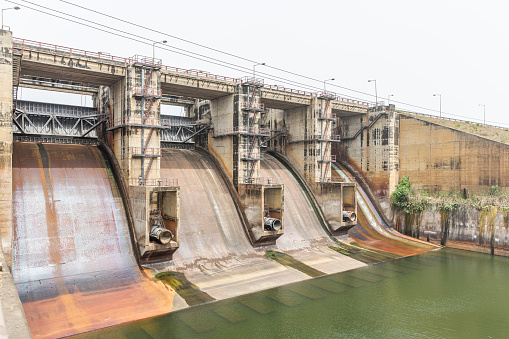
Ogun River Flooding: Relocate in Your Own Interest, Lagos Warns Residents
CHIGOZIE AMADI
Following the imminent over flowing of the Oyan Dam on the Ogun River, Lagos government yesterday warned residents and property owners on the banks of the Ogun River to be ready to relocate to higher grounds, saying the Ogun-Osun River Basin Development Authority (OORDBA) will commence a staggered release of water from the dam.
Addressing the media during a briefing at Alausa, Ikeja, the Commissioner for Environment and Water Resources, Mr. Tokunbo Wahab, said Lagosians needed to be alerted on the commencement of release of water to maintain the sanctity of the dam and its socio-economic implications for the state.
He said it is crucial to understand that the dam’s annual operations are informed by real-time hydrological data, rainfall predictions from the Nigerian Meteorological Agency (NIMET) and flood outlooks from the Nigeria Hydrological Services Agency (NIHSA), emphasising that these sources guide the water release decisions to ensure both flood control and the integrity of the dam.
He said the state government and the OORBDA acknowledge the concerns raised regarding the release of water from the dam and its impact on surrounding communities, particularly those along the Ogun River water channels extending into Lagos State.
He said from its released guidelines, OORBDA operates the dam in strict compliance with safety protocols to prevent structural damage and mitigate flood risks.
He added that a detailed operational report by OORBDA states that the total water released from the dam this year, as of 12th October 2024, stands at 1,484.2 million cubic meters (mcm), which remains below the average synthesised annual flow volume of 1,770 mcm.
He stressed that although rainfalls across the Oyan River catchment area have been significant, with a cumulative 984.1 mm recorded this year, it remains lower than last year’s 1,540.8 mm and is within safe operational levels.
He explained that the dam is equipped with four radial gates capable of releasing up to 2,271 cubic meters per second (m³/s) during peak periods and the current releases are measured at 208 m³/s, with only two gates opened at 12 per cent capacity each, ensuring controlled and steady discharge.
Wahab added that 62.1 per cent of the dam’s flood control capacity remains intact with the Dam not under any imminent threat of releasing excess water beyond safe limits saying this has been made possible through the collaboration of the State with OORBDA.
He said the state government fully recognises the challenge faced by residents in affected communities which include Kara, Mile 12, Agiliti, Ikosi Ketu, Owode, Ajegunle, and Odo-Ogun as reported.
“However, I want to emphasise that while the flooding experienced in these areas has often been attributed solely to water released from the Oyan Dam, this is not entirely the case. In reality, the downstream section of the Ogun River is influenced by a complex network of over 52 tributaries, all of which converge and contribute to rising water levels in the affected areas,” he said.
He said these tributaries, combined with rain-induced runoff, significantly exacerbate the flood situation adding that this is a critical point to consider when addressing flood management strategies for this region.
He stated that in an effort to reduce the flood risks and ensure the free flow of water within the Ogun River system, OORBDA recently flagged off the dredging of the Ogun River downstream from the Ikorodu to Isheri axis (Ajelogo, Owode-Elede, Ajegunle, and under deck-on-pile of Itowolo Bridge) for the water released on Friday, 13th September 2024.
He stressed that some right-of-ways along the catchment areas were protected and restored, saying that the dredging project was a proactive measure to deepen the river channel and increase its capacity to convey water, thereby reducing the likelihood of flooding during periods of high inflow.
The commissioner said to effectively contain flooding the government is determined to maintain the long-established synergy and partnership with OORBDA which has ensured control and monitoring of the steady and systematic release of water from Oyan Dam to prevent flooding of the downstream communities.
He said the state government would continue to monitor the situation closely and collaborate with relevant agencies and affected communities, to address humanitarian concerns, particularly for vulnerable groups like women, children, the elderly, and people living with disabilities.
Wahab also informed that the Emergency Flood Abatement Gang under Drainage Maintenance Department of the Ministry has been consistently de-silting and working on secondary collectors and conduits, to enable them discharge efficiently and act as retention basins as part of statewide measures to prevent flooding.
He appealed to Lagosians to desist from indiscriminate dumping of refuse in unauthorised places, throwing pet bottles on the roads, clogging of drains with silt or construction materials, erecting building structures within and around drainage Right of Ways/setbacks, stop discharging human waste into drains/canals which encourages high siltation and vegetal growth that easily clogs the canals as these act impedes the free flow of water.
He urged Lagosians to report cases of drainage blockages, dumping of waste into canals and other unauthorized places to Resident Engineers offices statewide saying Drainage Engineers with their telephone numbers will be made available in all our 57 Local Government Areas and Local Council Development Areas to attend to all your needs.
In his words: “I wish to appeal once again to our people to support our efforts by complementing the State Government through regular clearing of drains in their frontages to ensure free-flow of storm water as well as to desist from dumping of refuse into drainage channels and roads.

























